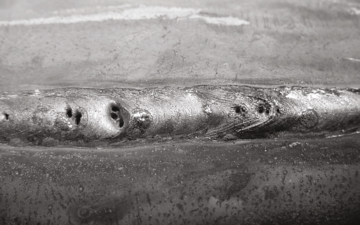What is Porosity in Welding: Recognizing Its Reasons and Enhancing Your Abilities
What is Porosity in Welding: Recognizing Its Reasons and Enhancing Your Abilities
Blog Article
The Scientific Research Behind Porosity: A Comprehensive Overview for Welders and Fabricators
Comprehending the intricate systems behind porosity in welding is critical for welders and fabricators making every effort for flawless workmanship. As metalworkers look into the midsts of this phenomenon, they discover a globe controlled by numerous aspects that affect the development of these minuscule gaps within welds. From the composition of the base materials to the complexities of the welding procedure itself, a plethora of variables conspire to either worsen or ease the visibility of porosity. In this thorough guide, we will untangle the science behind porosity, discovering its results on weld top quality and unveiling progressed techniques for its control. Join us on this journey through the microcosm of welding imperfections, where accuracy fulfills understanding in the pursuit of remarkable welds.
Understanding Porosity in Welding
FIRST SENTENCE:
Examination of porosity in welding exposes important insights right into the honesty and top quality of the weld joint. Porosity, characterized by the existence of tooth cavities or spaces within the weld metal, is a common concern in welding processes. These spaces, otherwise effectively attended to, can jeopardize the architectural integrity and mechanical homes of the weld, resulting in prospective failures in the finished product.

To identify and evaluate porosity, non-destructive testing methods such as ultrasonic testing or X-ray inspection are typically employed. These methods permit the recognition of inner problems without jeopardizing the integrity of the weld. By evaluating the dimension, form, and distribution of porosity within a weld, welders can make enlightened decisions to boost their welding procedures and attain sounder weld joints.

Elements Affecting Porosity Formation
The incident of porosity in welding is influenced by a myriad of factors, varying from gas securing efficiency to the complexities of welding criterion settings. One vital factor contributing to porosity formation is poor gas protecting. When the shielding gas, usually argon or carbon dioxide, is not efficiently covering the weld swimming pool, climatic gases like oxygen and nitrogen can pollute the molten metal, resulting in porosity. Additionally, the cleanliness of the base materials plays a substantial duty. Contaminants such as corrosion, oil, or dampness can vaporize during welding, creating gas pockets within the weld. Welding parameters, including voltage, existing, take a trip speed, and electrode kind, likewise impact porosity Discover More Here formation. Utilizing improper settings can produce too much spatter or warm input, which consequently can cause porosity. Additionally, the welding technique utilized, such as gas metal arc welding (GMAW) or secured steel arc welding (SMAW), can affect porosity formation because of variants in warmth distribution and gas insurance coverage. Understanding and regulating these elements are crucial for minimizing porosity in welding operations.
Impacts of Porosity on Weld Quality
The visibility of porosity likewise compromises the weld's resistance to deterioration, as the entraped air or gases within the voids can respond with the surrounding setting, leading to degradation over time. Additionally, porosity can prevent the weld's capability to endure pressure or influence, additional endangering the total quality and dependability of the welded have a peek at these guys framework. In crucial applications such as aerospace, vehicle, or structural building and constructions, where safety and durability are vital, the detrimental impacts of porosity on weld high quality can have serious consequences, emphasizing the significance of reducing porosity via correct welding techniques and treatments.
Methods to Reduce Porosity
Additionally, using the ideal welding specifications, such as the proper voltage, present, and take a trip rate, is critical in preventing porosity. Keeping a consistent arc length and angle throughout welding additionally assists lower the probability of porosity.

Making use of the appropriate welding technique, such as back-stepping or using a weaving motion, can also help disperse warmth evenly and minimize the chances of porosity development. By carrying out these methods, welders can properly reduce porosity and generate top notch bonded joints.

Advanced Solutions for Porosity Control
Applying innovative technologies and ingenious techniques plays a critical duty in attaining remarkable control over porosity in welding processes. One sophisticated option is making use of sophisticated gas mixes. Protecting gases like helium or a mixture of argon and hydrogen can help lower porosity by providing far better arc stability and improved gas coverage. In addition, employing advanced welding strategies such as pulsed MIG welding or customized atmosphere welding can likewise assist reduce porosity issues.
An additional sophisticated option entails using advanced welding equipment. For circumstances, making use of devices with built-in functions like waveform control and sophisticated source of power can improve weld this contact form high quality and reduce porosity risks. The execution of automated welding systems with specific control over parameters can significantly reduce porosity flaws.
Additionally, including sophisticated tracking and inspection technologies such as real-time X-ray imaging or automated ultrasonic screening can aid in identifying porosity early in the welding procedure, permitting immediate restorative activities. Generally, integrating these advanced options can substantially improve porosity control and enhance the general top quality of welded elements.
Final Thought
In conclusion, understanding the scientific research behind porosity in welding is important for welders and fabricators to produce top notch welds - What is Porosity. Advanced solutions for porosity control can better boost the welding process and ensure a solid and reliable weld.
Report this page